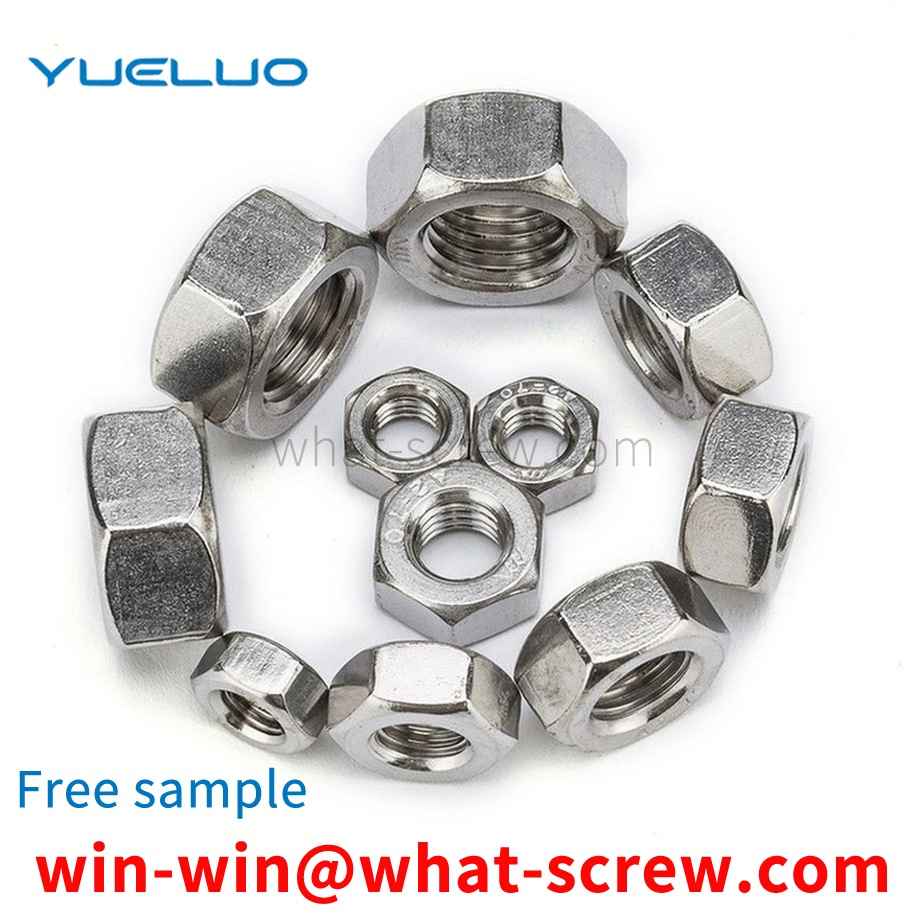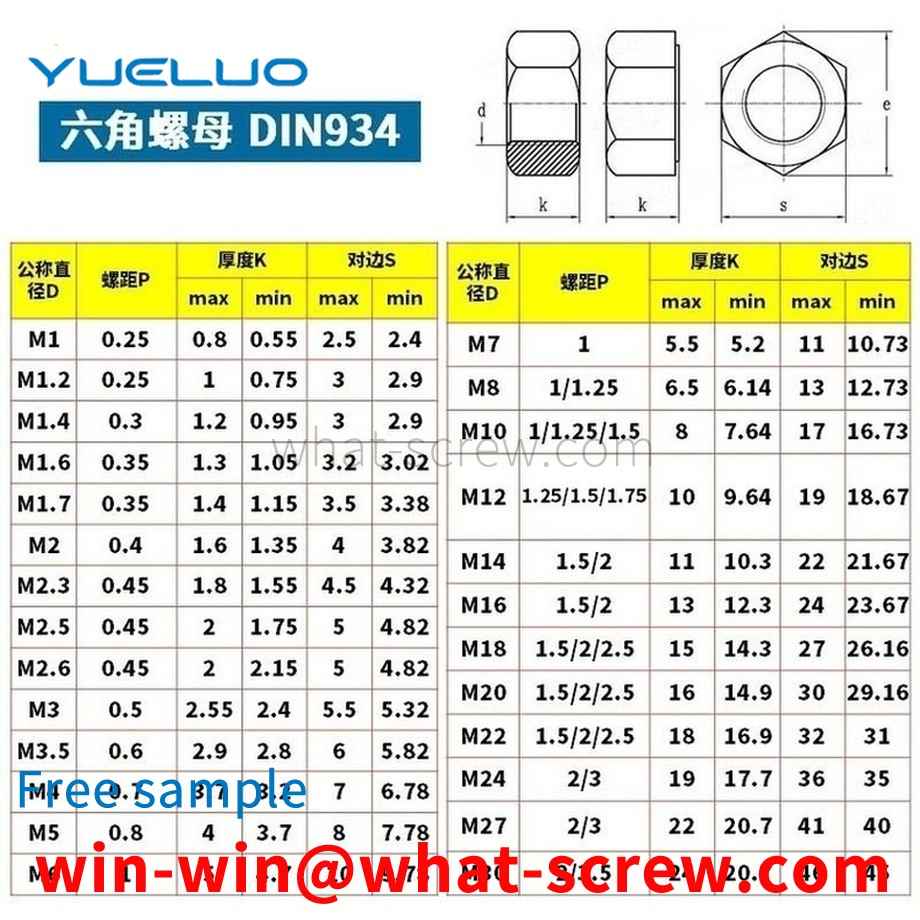The main categories of screws include ordinary screws, machine screws, self-tapping screws and expansion screws. Cap screws used to be limited to full-thread fasteners. Hex cap screw and Hex bolt Hex bolt As the name suggests, it is a male threaded fastener with a hexagonal head, designed to be turned with a wrench. According to the ASME B18.2.1 standard, the head height and shank length tolerance of the hexagon head screw (Hex cap screw) is smaller than that of the general hex bolt (Hex bolt), so the ASME B18.2.1 hexagon screw is suitable for installation in all hexagon bolts that can be used. places, also including places where the large hex bolts are too large to be used. Socket cap screw (also known as socket head screw or) is a screw with a hexagonal inner hole on the head, which can be tightened or loosened only after a hexagonal ruler (hex key, Allen wrench or Allen key) is inserted into the inner hole. The most commonly used hexagon socket head screws are cylindrical head screws with a head diameter of about 1.5 times the main diameter of the thread (1960 series). Countersunk head cap screw. The counterbore design allows the screw head to rotate without being exposed on the surface of the fixed object, so it is mostly used in places where the surface is small and traditional wrenches are inconvenient to use. Machine screw is generally a screw (4#~12#) with a diameter less than ¼ inches, usually full teeth and rotated by a screwdriver, such as slotted, cross or hexagon socket. Wood screws, machine screws; but can be divided into many categories according to different uses; machine screws can be divided into longitudinal tightening screws and horizontal expansion screws; according to the thread can also be divided into: A: Triangular thread (60 degrees ) : combined/locked/expanded B: triangular thread for pipe (55 degrees): combined/locked 3) C: trapezoidal thread (30 or 29 degrees): power transmission D: square thread (90 degrees): power transmission stainless steel screw Stainless Steel Anti-Drop ScrewsStainless Steel Anti-Drop Screws Machine (Treadmill) Screws And Shafts For Motorcycle Or Bicycle Needle Car Screws, Axes Screws And Shafts For Sewing Macing Socket Set Screws Stainless Steel Wide Thread ScrewsStainless Steel Coarse Thread Screws Stainless Steel High-Low Thread Screws Stainless Steel Machine Screws Stainless Steel Self Drilling Screws Stainless Steel Self Tapping Screws Stainless Steel Self Tapping Screws Stainless Steel Thread Cutting Screws Stainless Steel Triangle Stainless Steel Tri-Lobular Thread Screws Model Description P refers to the head type is PAN head; A refers to the pointed tail teeth, B refers to the flat tail teeth, namely PA round head pointed steel teeth, PB round head flat mouth steel teeth. Self-tapping type: ◆Round head self-tapping screw PA ◆Round head flat tail self-tapping screw PB ◆Round head cutting tail self-tapping screw PT ◆Round head belt self-tapping screw PWA ◆Round head belt and flat tail self-tapping PWB ◆Round head belt Jiecut tail self-tapping PWT ◆Countersunk head self-tapping screw KA ◆Countersunk head flat tail self-tapping screw KB ◆Countersunk head cut-tail self-tapping screw KT ◆Semi-countersunk head self-tapping screw OA ◆Big head self-tapping screw BA ◆Big head flat tail self-tapping screw BB ◆Large flat head self-tapping screw TA ◆Large flat head flat tail self-tapping screw TB ◆Large flat head cutting tail self-tapping screw TT ◆Thin head self-tapping screw CA ◆Thin head flat tail self-tapping screw CB ◆Cup head hexagon socket self-tapping HA ◆Drywall/Wallboard/Fiber Nails Machine Wires: ◆Round Head Machine Screw PM ◆Round Head Machine Screw PWM ◆Large Flat Head Machine Screw TM ◆Countersunk Head Machine Screw KM ◆Half Countersunk Head machine screw OM ◆Large head machine screw BM ◆Thin head machine screw CM ◆Cup head machine screw HM
Although this structure can prevent the shaft from rotating radially to a certain extent, it also has some obvious defects: firstly, the positioning block needs to be opened during processing, and secondly, the opening of the positioning block needs to be opened. After the deformation, the contact between the positioning block and the shaft becomes line-to-line contact, so that the contact area between the positioning block and the shaft is reduced, and the force generated to overcome the radial rotation of the shaft is correspondingly changed. less, so there is a risk that the shaft can turn radially.
The conventional auger bit structure 1 includes a rod body 11, a screw head 12 provided on one end of the rod body 11, a drill tail 13 provided on the other end of the rod body 11, and a plurality of threads 14 arranged around the rod body 11; Wherein, the periphery of the drill tail 13 defines a parting line 15, and the parting line 15 makes the drill tail 13 symmetrically divided into a side 131 and a side 132, and a cutting end 133 is formed at the junction of the end of the side 131 and the end of the side 132, respectively. The cutting end 133 is concavely provided with a quarter-turn chip flute 134 in the same direction of the helix, and the edge 132 continues the chip flute 134 and has a quarter-turn chip flute 135 with different helical curvatures. , by connecting the chip groove 134 and the chip groove 135 through different helical curvatures, the drill tail 13 can form a symmetrical and complete chip groove of 186 degrees.
The technical process of nickel-phosphorus plating for high-strength bolts consists of three parts: The first part is the pre-treatment process, including the precision and appearance inspection of high-strength bolts before plating, manual degreasing, immersion degreasing, pickling, electro-activation and flash nickel plating and other processes; the second part is the electroless nickel plating treatment process; the third part is the post-treatment process, including the processes of hydrogen-displacing heat treatment, polishing and finished product inspection. As follows: Bolt chemical composition inspection → bolt pre-plating accuracy, visual inspection → manual degreasing → visual inspection → immersion degreasing → hot water washing → cold water washing → pickling → cold water washing → electric activation → cold water washing → flash nickel plating → cold water washing → Deionized water washing → Electroless nickel plating → Deionized water washing → Cold water washing → Hydrogen removal → Polishing → Finished product inspection.
The main part of the pin screw is an ordinary screw, and the pin can be arranged in the melting section of the screw or the drop groove of the metering section or the smooth cylindrical surface without screw grooves at the end of the metering section. The pins are arranged in a certain arrangement, with varying degrees of density and quantity. Cylindrical pins are formed by fitting the pins into the holes of the threaded rod; square or diamond-shaped pins are formed by milling directly on the threaded rod. If these pins are set in the melting zone, the pins can break up the solid bed, destroy the two-phase flow, stir the solid and liquid phases together, increase the contact area between the undissolved solid phase fragments and the contained material, and promote molten. If the pin is set in the melt conveying area, its main function is to divide the material flow, increase the interface, change the direction of the material flow, and rearrange the flow beam. Divide and merge multiple times, change the flow direction, and homogenize the melt composition and temperature. The mixing section is an inwardly slotted structure arranged at the end of the common screw homogenizing section, and its outer diameter is equal to the outer diameter of the screw. The grooves are divided into several groups, and each group is the confluence area of the material. The materials are divided by grooves, meet in the confluence area, and then divide and confluence. The principle is similar to the pin type. The characteristic of the separate screw is that in addition to the original screw thread (called the main screw) on the melting section, there is also an additional thread (called an additional thread) whose outer diameter is slightly smaller than the outer diameter of the main thread, and the main and auxiliary threads are With different leads, the secondary thread starts from the end of the feeding section (and connects with the feeding section here), and after several threads, gradually intersects the main thread of the homogenizing section. The screw groove depth and thread lead of this kind of screw change gradually from the beginning of the feeding section to the end of the homogenization, that is, the thread lead gradually narrows from the width, and the groove depth gradually becomes shallower from the depth, which can maximize the compression of the material.
We have many years of experience in the production and sales of screws, nuts, flat washers, etc. The main products are: bearing spring washers, high-strength bolts, flat head screws, screw bolts and other products, we can provide you with suitable fastener solutions for you Program.



















 Service Hotline
Service Hotline




